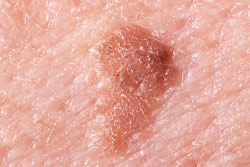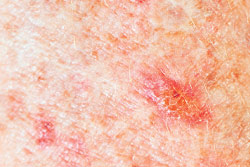How Sun Damage Ages Your Skin
Warning Signs Of Too Much Exposure Tips For Prevention And Treatment
(Continued)
Photo-aging
Photo-aging is truly the crux of the matter. Frequent and repeated sun exposure and sunburns accelerate aging of the skin making you look older than you are. Common associated skin changes include:
- Freckles especially on the face
- Dry and rough skin
- Reduction and weakening of the elastic fibers, reducing strength and resilience
- Damage and weakening of the connective tissues in the skin's substructure
- Thinning of the skin making it more translucent or see-through
- Deep wrinkling
- Fine red blood vessels appearing on the cheeks, nose and ears
- Large brown macules (flattened spots) on the face, and solar lentigines (liver spots)
 |
| Darkening patches of facial skin giving the skin a mottled, spotty look. |
 |
| A liver spot or solar lentigine is named because its size and appearance resemble a lentil bean. |
 |
| Actinic keratosis is a rough, scaly patch that develops on your skin from years of exposure to the sun. Doctors consider it to be precancerous because it may evolve into skin cancer. |
Results Of Chronic Sun Exposure And Aging
Sun damage takes many forms, some more serious than others. What follows is a brief overview of some of the most common conditions caused by photo-aging.
While your dentist or physician might notice changes associated with photo-aging when you are in their offices, it is best left to a dermatologist (skin specialist) to diagnose a particular mark or marks on your skin. Here are some of the things you may notice if you have sustained sun damage:
Uneven pigmentation: To protect itself from the damaging effects of the sun, the skin makes the dark brown pigment melanin, which is produced by melanocytes (“melano” melanin-producing; “cyte” cell). Melanin makes your skin look darker or “tanned.” With age, the sun causes an uneven increase in melanin production and/or in the number of melanocytes, giving rise to irregular pigmentation or blotching. The sun can also cause a permanent stretching of small blood vessels, giving the skin a mottled, reddish look. This can manifest as:
- Darkening patches: Brown, darkening patches of facial skin form as a result of a combination of factors, including sun and an increase in female hormones. Known as melasma (“melasma” – from Greek, black spot), this condition tends to affect women with dark skin and who take oral contraceptives or hormone therapy, or who are pregnant. Appearing with pregnancy, it is also referred to as chloasma or “mask of pregnancy.” The dark patches usually occur on the cheeks, forehead, nose and chin.
- Age spots: Sometimes called “liver spots,” they are also known as solar lentigines (“lentigo” – lentil bean) because of their appearance. They tend to be darker than the usual freckle and do not fade in winter. They vary in size and usually appear in areas most exposed to the sun such as the face and hands. Although they are more common in older people, they also occur in younger adults and even in children who spend too much time in the sun.
- Lip spots: If you have a single dark brown spot on the lower lip, it could be a labial lentigo — from labial, meaning lip. Labial lentigos tend to develop after repeated sun exposure.
Most of these conditions can be treated with the medication hydroquinone available over-the-counter or by physician prescription, which is used to bleach abnormal pigment. In-office dermatologic treatment using laser therapy or chemical peels can also help remove unsightly staining and visible discoloration. But beware, to protect your skin from recurrent staining, avoid more sun exposure.

